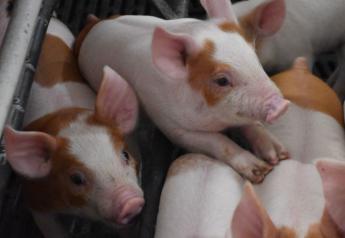Genetic Diversity Makes Swine Influenza a Challenge for Producers

Influenza A virus in swine (IAV-S) is one of the primary respiratory pathogens challenging swine production systems in the U.S. and around the world, said Phil Gauger, DVM, PhD, an associate professor at Iowa State University. The virus is transmitted from pig to pig quite easily, and the movement of pigs over long distances has contributed to IAV-S problems within swine production systems, Gauger told Pig Health Today.
“Probably one of the biggest factors that has continued to make IAV-S such an issue is its genetic diversity. That genetic diversity ultimately leads to issues with developing effective vaccines that can control the virus,” Gauger said.
Unique genetic nature
IAV-S is a segmented virus so it can undergo a process called reassortment, Gauger said. Virus reassortment “is a process of genetic recombination that is exclusive to segmented RNA viruses in which co-infection of a host cell with multiple viruses may result in the shuffling of gene segments to generate progeny viruses with novel genome combinations,” according to the National Institutes of Health. Small changes in the genome can add to that diversity, too, Gauger added.
Another factor worth noting is the interplay between human and swine influenza viruses, he said. Often, human influenza viruses spill over to pigs. They’re sporadically detected, but occasionally one of the human influenza viruses will establish itself within the swine population. It adapts to swine and becomes a new genetic clade, which is another level of genetic diversity, Gauger explained.
Ask the right questions
Whether diagnosing or monitoring IAV-S, asking the right questions is important.
“We have molecular diagnostic tests in place that will actually detect the presence of the virus, but we also have serology tests that detect the presence of antibodies,” Gauger said. “We go back to the same theme of genetic diversity within the virus itself.”
The tests have narrowed the scope of determining whether a herd has been exposed to IAV-S and its vaccination status. Producers need to consider the age of the pigs they’re testing for antibodies and then see what’s available at the diagnostic lab to give the desired results.
Good test techniques are in place to detect different strains of IAV-S, but veterinarians are sometimes confused with the genetic diversity and sequencing associated with diagnosing the virus.
“We go from testing the sample that comes from a pig to know whether or not flu is present, and then we test for particular subtypes…, which are primarily H1 or H3 viruses. Then we typically need to go to sequencing, because that information is going to be used to tell whether or not a particular vaccine is going to be useful within the farm,” Gauger said.
Endemic infections
Endemic infections that occur in baby pigs while they’re still with their mothers are often overlooked, Gauger said. Piglets might not show clinical signs of disease, but they can still be infected with IAV-S and can carry the virus into the nursery.
“One of the more innovative sample types would be an udder wipe,” Gauger said. “This is where you take a gauze pad and wipe along the udder skin of the mother pig.”
Obviously, that’s where the piglets are nursing and those nasal secretions can build up. The udder wipe can be soaked in a culture media and then tested for IAV-S as a population-type sample.
“[This test] gives a very good picture of what types of influenza are circulating already at that age,” Gauger said.
In the nursery phase, nasal wipes can take the place of nasal swabs, which can be more labor-intensive.
“You can wipe a gauze just across the nose of the pig, and those nasal secretions are picked up,” he said. “They’re good for detecting flu as well.”
Take testing to the next level
Sometimes veterinarians and producers believe if they’ve identified a particular subtype of either H1 or H3 they don’t need any other genetic characterization of the virus, but Gauger said that’s not enough.
Not taking the time to sequence the virus is a missed opportunity, Gauger advised.
“You can easily get the virus sequence from the diagnostic lab report and put that into a program with previous sequences for a historical picture of flu exposure in the herd,” he said. The process allows producers and their veterinarians to monitor the virus to see if it is slowly changing over time and if a new vaccine is needed.
Real-time polymerase chain reaction tests can identify if a pig is positive or negative to IAV-S and can also provide a “cycle threshold (Ct) time.” The Ct is defined as the number of cycles required for the fluorescent signal to cross the threshold (i.e., exceeds the background level).
“The [Ct] basically has an inverse correlation with the amount of virus in the sample,” Gauger said. “When I’m working with different veterinarians who call into the diagnostic lab and have questions about their results, I’m looking at that Ct value to make a decision whether or not doing some subtyping or sequencing would be successful.”
A PCR test has high sensitivity and can detect small quantities of virus in a sample. If virus is present but in low concentrations, Gauger recommended collecting additional samples from pigs that may be more acutely affected with IAV-S. Those values are then correlated with the clinical context of the case.
Take-home message
Veterinarians and producers should talk with personnel at the diagnostic lab to better understand IAV-S test results from their respective farms, Gauger recommended.
“If you’re going to do the sequencing and you don’t understand the outcomes, then you’re not going to be given the opportunity to make any sort of productive change within the herd itself with evidence-based decisions, particularly regarding what vaccines to use,” he said.
It’s also important to know where infections originate and where they are persisting.
“We are still concerned about incoming gilts that could be carrying new strains of flu, so it would be important to be doing some diagnostic testing or monitoring there,” Gauger pointed out.
Routine monitoring and sequencing are critical from a control standpoint. “It’s vital if you’re going to make changes in that regard,” Gauger said.
More from Farm Journal's PORK:
Pig Studies Show Human Antibody Could Provide Protection from Flu
The Truth About Influenza and Pigs
6 Ways to Protect Pigs and People at the Fair
Protect Your Pig Farm: Get Your Flu Shot
Piecing the Puzzle Together: Diagnostic Monitoring and Flu Prevention







